For years the United States has neglected a core element of its security and prosperity—its commercial maritime strength. Of the more than 80,000 ships arriving at American ports, fewer than 200 are U.S.-flagged, -owned, and -crewed.REF American shipping and shipbuilding have atrophied, but this problem can be solved. The United States needs to unleash American potential to ensure that the nation’s security and prosperity are not hostage to the whims of unfriendly nations.
Despite the best intentions of the century-old Jones Act,REF the few ships that are domestically produced, flagged, and crewed are not competitive in the world marketplace. One estimate from the Department of Defense’s U.S. Transportation Command estimates that regulatory costs, mandates, and labor costs render U.S.-produced ships 26 times more expensive than sourcing overseas,REF which must be recouped via higher shipping rates, with costs estimated at $9.8 billion per year.REF The problem includes human capital, and the United States continues to struggle to grow its maritime workforce, especially ship crews.REF
To remedy this, the nation needs to modernize its domestic maritime sector, which will require partnering with dependable long-time maritime allies such as Japan, Korea, and the Philippines. Just as America would not be able to dominate technology without cheap microchips from Taiwan, America cannot dominate the maritime frontiers if it is locked into inputs costing 26 times the going rate. By creating these partnerships, the nation can regain a competitive edge against China.
Critically, America has not sustained a viable merchant marine fleet, nor has its supply of merchant shipping sustained its military in securing its national interests abroad. The consequence is that the nation is today prone to economic blackmail by nations such as China, a sample of which was evident during the COVID-19 pandemic when container shipping backed up in U.S. ports.REF A stronger and globally competitive U.S. maritime sector serves as a deterrent to Chinese economic coercion and military adventures, because with it American trade can proceed with confidence even during a crisis with China, and the U.S. military will be able to sustain combat operations on U.S.-flagged vessels.
A recent Heritage Foundation paper detailed how several key technologies could revolutionize shipping and shipbuilding.REF However, attracting the investments and political will requires a proof-of-concept demonstration. This was how today’s container shipping came about, which still dominates maritime shipping. At the same time, given today’s global economy and supply chains and the paucity of U.S. commercial shipbuilding, shipping, and merchant marines, a consortium of like-minded maritime nations will need to work together to ensure long-term success.
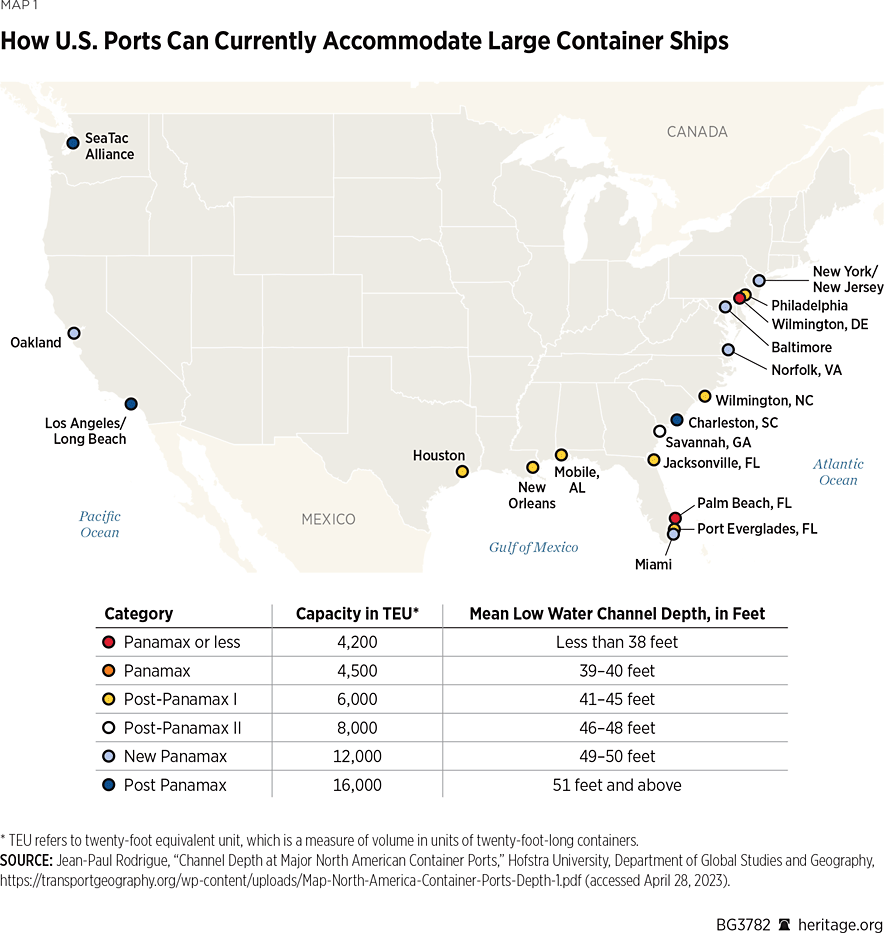
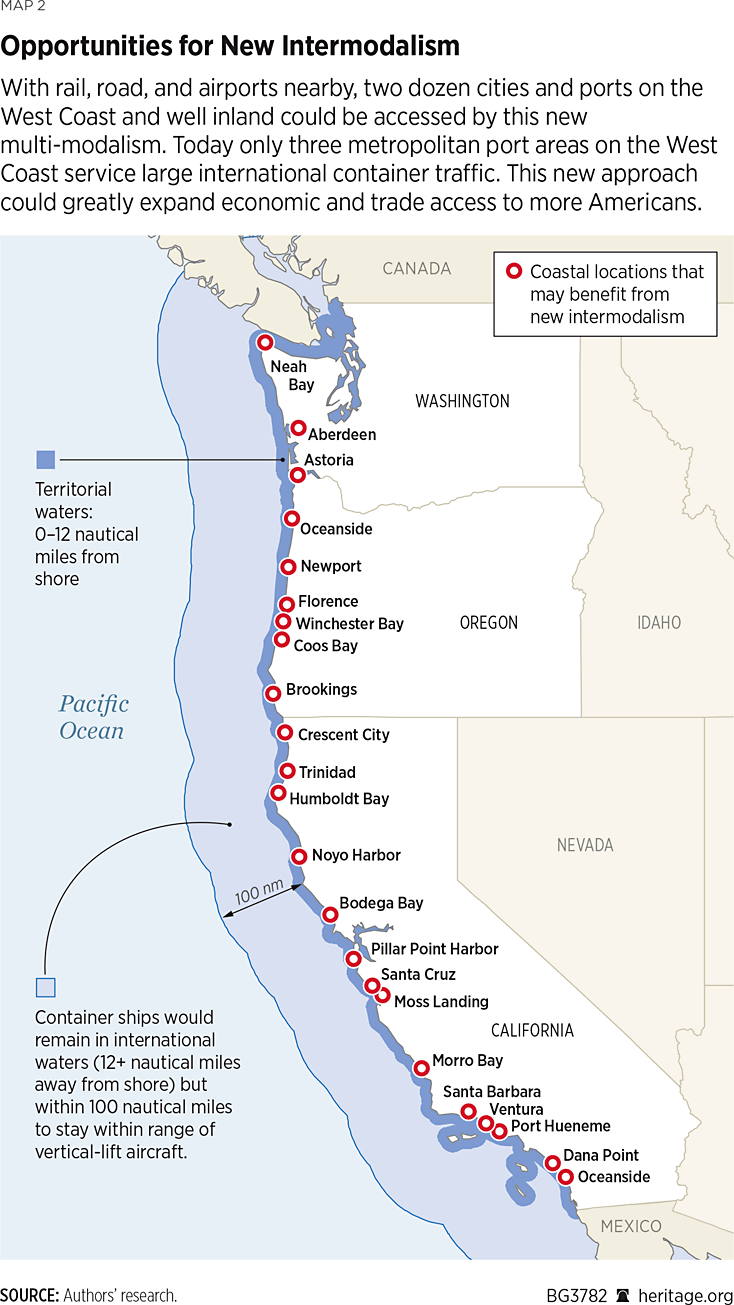
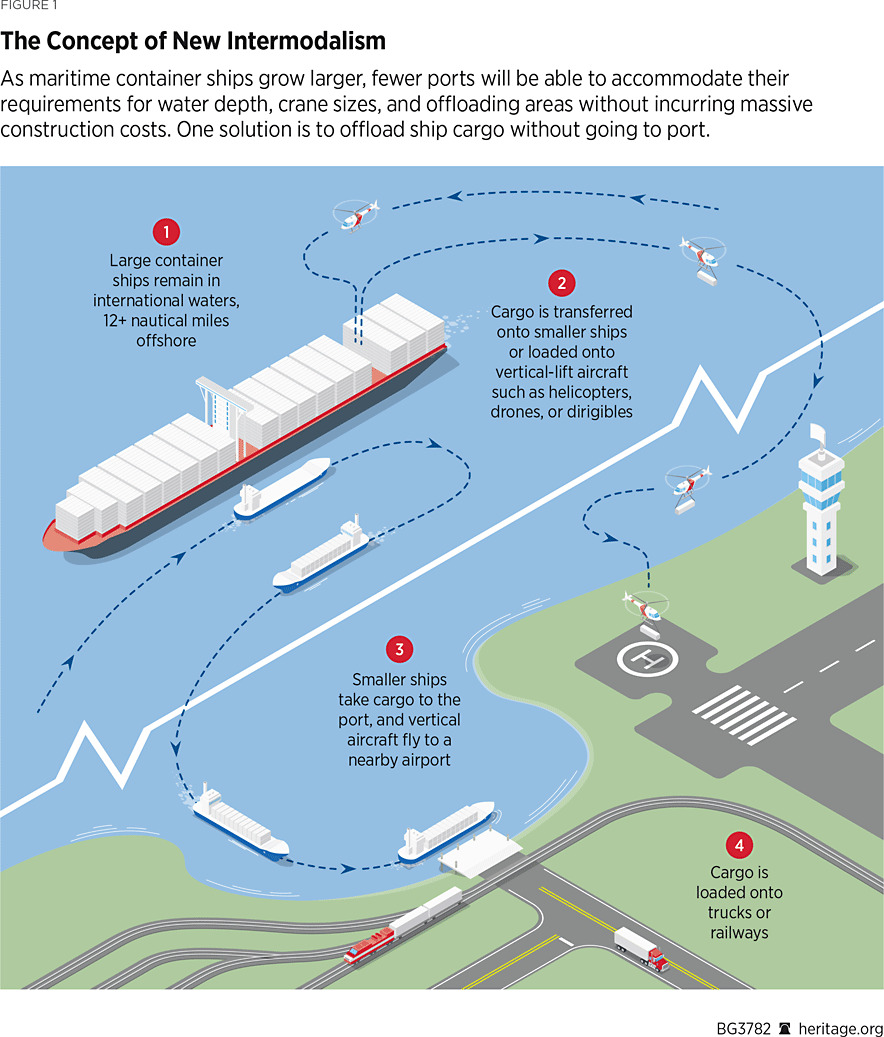
Lessons of America’s Last Shipping Renaissance
American shipping and shipbuilding missed a rare opportunity for rejuvenation with the invention of container shipping, the brainchild of American businessman Malcolm McLean. To improve his long-haul trucking business, he took advantage of cheaper and faster transit by sea. In April 1956, using a repurposed wartime cargo ship and strengthened truck trailers, he executed a proof of concept that sparked a revolution in shipping: containerization.REF
Regrettably for American shippers, the need for large port staging areas and limited carrying capacity of early container ships slowed what should have been a dominant American position in intermodal shipping. McLean lost the advantage to the Japanese, who had already embraced another American invention—modular ship construction. The lesson is that, without first developing a pathway to economic sustainability, any future multi-modalism concept will remain vulnerable no matter how soundly engineered, economical, or environmentally beneficial.
Neutering China’s State-Controlled Shipbuilding and Shipping Predations
Today the largest commercial fleet is China’s (when including Hong Kong), which is backed by the world’s largest shipbuilding sector enjoying significant subsidies from the Chinese Communist Party. This situation threatens the ability of the United States to sustain a wartime economy that in peacetime has become reliant on foreign shipping and shipbuilding.REF
China’s “civ-mil” fusion blends civilian activities such as shipping with military needs. It has focused on achieving a dominant position in global shipping, shipbuilding, and port operations.REF To this end, Chinese companies enjoy significant government backing: Between 2010 and 2018, Chinese shipbuilders received $132 billion in direct subsidies, which does not include vast indirect subsidies.REF Chinese shipbuilding also enjoys a relaxed regulatory environment that avoids the enormous costs of U.S. environmental, labor, and special interest regulations.
China does not play by free-market rules, which poses a threat to any disruptive new entrants to the shipping and shipbuilding sector. The risk is not just the military use of commercial ships and ports in war but the ability to edge out market competitors and stifle any innovation contrary to Chinese interests. Contending with this situation requires challenging China’s state-owned shipping sector, setting a favorable regulatory environment, and leveraging the resources of several major players in this sector.
After decades of neglect, the U.S. maritime sector alone cannot take on China’s goliath state-controlled shipping and shipbuilding sectors, but a consortium of like-minded maritime nations could. Common interests regarding freedom of navigation, free trade, and a shared threat perception of China would bind the group together. This new grouping could together represent a formidable bloc critical for an American-led revolutionary transformation in shipping.
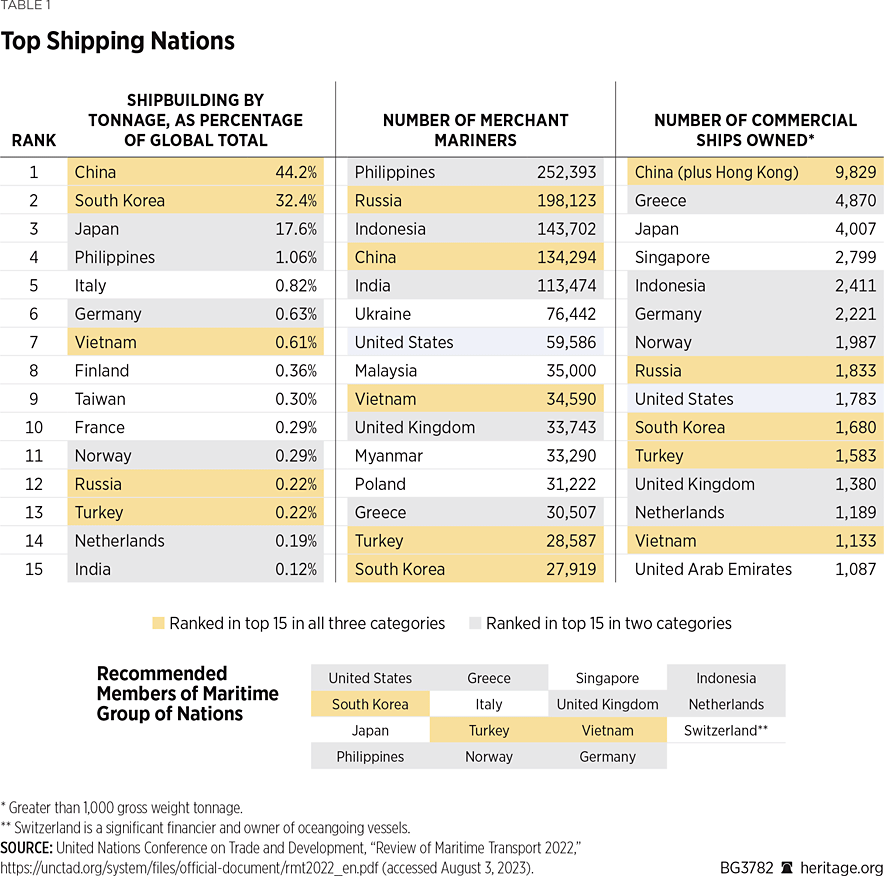
No One Cares Until a Novel Intermodalism Proof of Concept Makes Them Care
A successful demonstration of the new multi-modalism envisioned would provide key insights into the engineering challenges and inform the operational costs of such a novel approach to shipping. Today there are several ports, technology companies, and local governments experimenting with new shipping innovations. A well-planned demonstration would show the way to link together their efforts. For this reason, location is key for an initial demonstration. Some good candidates are on the Great Lakes near current efforts to use drones for cargo movement; along the U.S. East Coast, where efforts are underway to reduce road and rail traffic; and smart ports technology being tested in Puerto Rico.
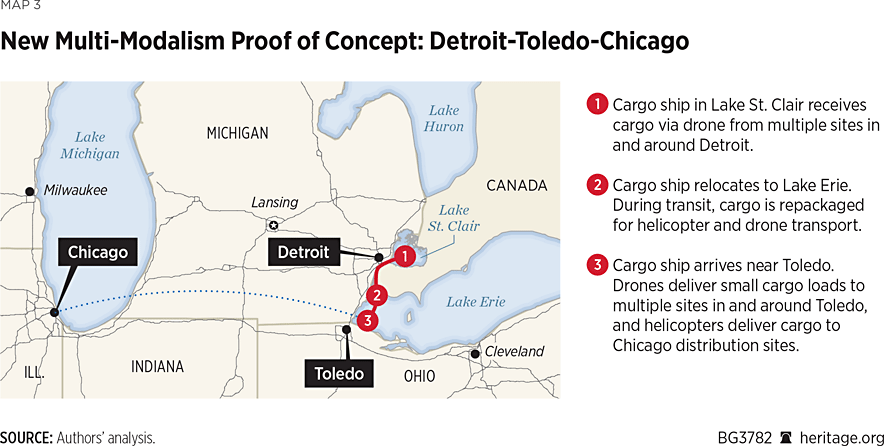
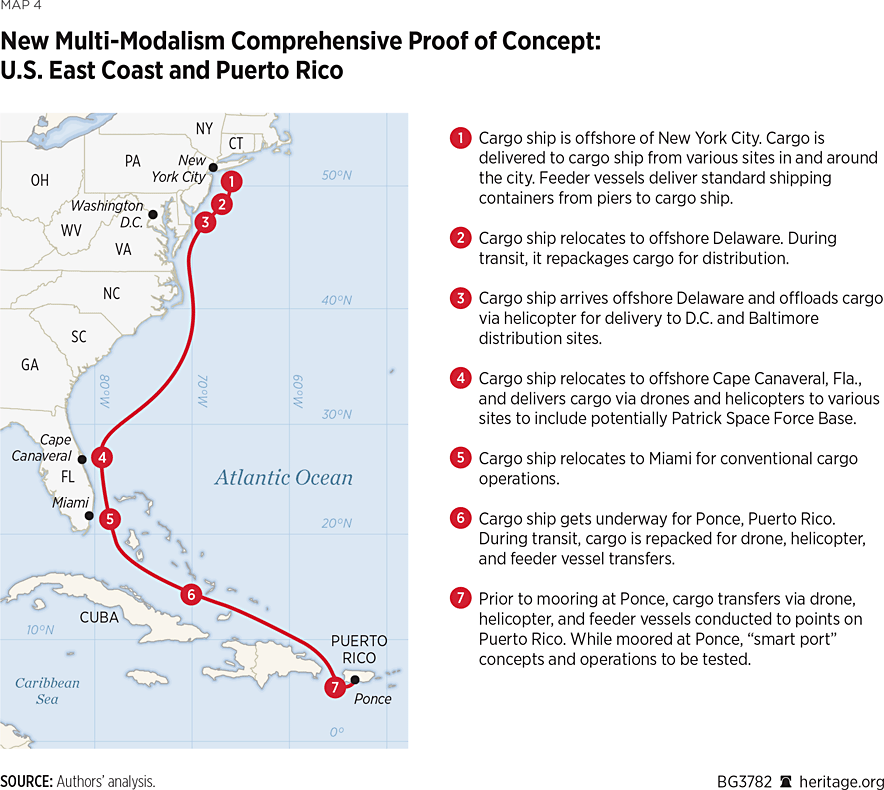
Recommendations
The Secretary of Transportation Should Establish a Maritime Group of Nations (MGN). The MGN would coordinate regulatory and commerce policies to facilitate a new multi-modalism—specifically, at-sea container traffic connected to shore via feeder vessels and further inland via vertical lift craft. The initial meeting of the MGN should be held in the United States with invitations for representatives from like-minded maritime nations. (A list of recommended participants is provided in Table 1.) Potential agenda items for the initial meeting could include assurances of access to shipping in crisis and regulation of small nuclear reactors in commercial shipping. Administratively, this effort would be led by the Secretary of Transportation and supported by interagency subject matter experts. Initial membership should include South Korea and Japan given their treaty alliances with the United States and the fact that they are in practice the only competitive countries to China in shipbuilding. Likewise, Indonesia, the Philippines, Poland, Turkey, and Vietnam—with their tens of thousands of experienced mariners—should be included. Additionally, Germany, Greece, the Netherlands, Norway, and Singapore have thousands of large commercial ships of their own, and they are currently developing novel methods of shipping. Lastly, Switzerland should be considered given its significant financial and chartered presence in the global maritime sector.REF
Industry, Community, Municipal, and State Leaders Should Welcome a Proof of Concept. While Congress and the executive branch should be engaged, it is industry and commercial investors who must bear the burden of executing a proof of concept. To get the greatest value and attract future investment, a comprehensive demonstration at Manhattan, Washington, Miami, or Ponce is recommended. Before this, a scaled initial demonstration on the Great Lakes should be held focusing on refining vertical lift and drone operations in high-traffic and populated areas to an offshore cargo ship. This two-step demonstration would inform business models, inform needed regulatory relief or action, and galvanize local and national attention.
Congress Should Establish a Special Committee on Regaining American Commercial Maritime Competitiveness. Congress, as it has attempted with its Commission on the Future of the Navy,REF should establish a select committee focused on American competitiveness in shipping and shipbuilding. Given that the maritime sector covers commerce, transportation, and national defense, the committee should hold routine hearings at a minimum with leadership from the Maritime Administration, the U.S. Coast Guard, and the U.S. Navy.
Conclusion
The United States has neglected a core element of its security and prosperity—its historic maritime strength. As a result, American shipping and shipbuilding has atrophied, yet domestic industry and capacity for innovation remain strong. This advantage needs to be pressed by restoring American maritime competitiveness in pursuit of a new multi-modalism.
A stronger and globally competitive maritime sector would deter Chinese economic coercion and military adventurism. With it, American trade can proceed unimpeded by dependency on others and with confidence that the U.S. military can sustain combat operations on U.S.-flagged vessels. The revolution in shipping could also mitigate environmental degradation, promote domestic production, and expand American exports to global markets, which can spur wider job growth and advance technological innovation. Getting underway on this renaissance of America’s maritime sector begins with a proof-of-concept demonstration.
Brent D. Sadler is Senior Research Fellow for Naval Warfare and Advanced Technology in the Center for National Defense at The Heritage Foundation. Peter St Onge is Research Fellow in the Thomas A. Roe Institute for Economic Policy Studies and Mark A. Kolokotrones Fellow in Economic Freedom at The Heritage Foundation.





